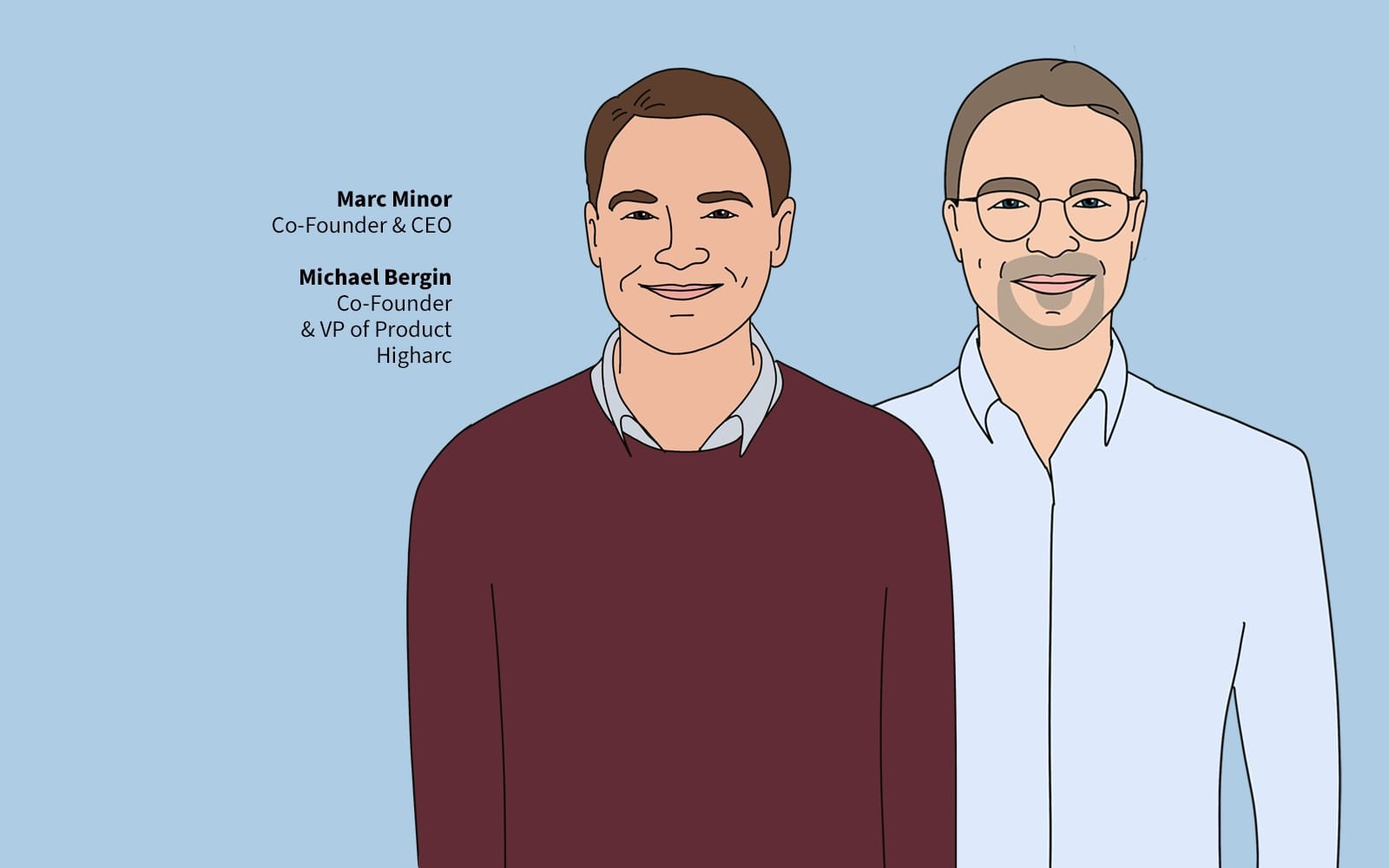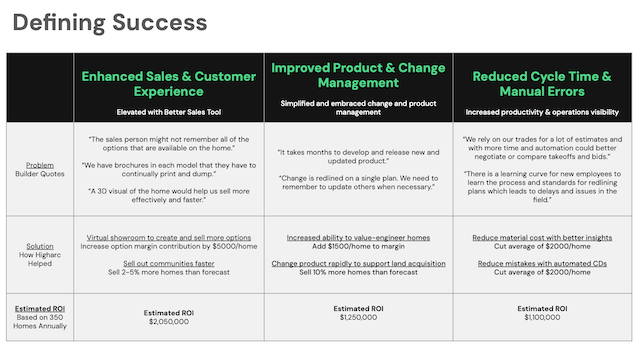Technology
What Higharc's New $53 Million Series B Round Will Power In 2024
We talk with Higharc's co-founders on what the latest significant capital infusion will mean for an enterprise tapping A.I. to help homebuilders transform how they design, sell, and build new homes and neighborhoods.

Higharc, a residential development and construction cloud technology trailblazer that managed to pivot over the past 24 months from a flicker of great promise to growing momentum and impact in the field, just got a fresh infusion of staying power.
The Durham, N.C.-based firm announced today it secured a $53 million Series B funding round that Higharc co-founder and CEO Marc Minor says attests "to the promise of unlocking data – now extended to a greater pool of homebuilders and beyond – among their partners in building materials and distribution."
According to Higharc's press statement:
Spark Capital and Pillar VC led the round, with participation from SE Ventures (Schneider Electric’s Venture Arm), Fifth Wall, Starwood Capital, Standard Investments, Home Depot, Ferguson, Simpson Strong-Tie, Mulhern+Kulp Engineering, Suffolk Technologies, RXR Realty, PSP Growth, Metaprop, SC Masterfund, Carl Bass — the former Autodesk CEO — along with leaders from Mighty Buildings, Welcome Homes, CBRE, and Ware Malcomb. ‘
The investment will be used to support Higharc’s growth and expand its automated materials estimating and generative AI-based workflows."
According to its media materials, Higharc has pioneered "The Homebuilding Cloud — the only connected platform that helps homebuilders transform how they design, sell, and build new homes and communities."
The infusion could signal a "canary in the coal mine" moment for investment enthusiasm in A.I., crossing over into the homebuilding domain significantly sooner than later. As to what that means for homebuilding operators and their ecosystem of business, trade, and distribution associates, we wrote in an earlier story about the context of a "homebuilding cloud" platform. A "transformed" building lifecycle would zero in on homebuying customers getting to pay only for what they value, and on homebuilders developing, designing, and building that faster, better, and more profitably:
Every vertical structure on every piece of dirt results from a scrum of only rarely fully-aligned energies, investments, interests, and stakes.
More often, forces necessary to the build cycle – localities, community activists, land sellers, investors, bank lenders, developers, builders, 25 to 30 subcontractors, architects, engineers, product manufacturers, distributors, inspectors, Federal agencies, plus lawyers, insurance costs, etc., ... not to forget home buyers or renters – conflict, or at best, see partially eye to eye.
Every project on every piece of dirt starts every scrum from scratch. And at every beginning, middle, and end of these complex hives of concurrent practices, value typically leaks, drains, or hemorrhages from its own value stream, piling the result of this lost value more or less directly on the backs of the people who want or need a home to live in.
In this context, the fusion of materially important discrete interests into a coherent and cohesive helix of physical, data, financial, human, and real estate resources – subjecting friction points to operational harmony, and accelerating the value-creating follow-on effects of velocity – becomes an opportunity to re-write typical outcomes of the residential build-cycle.

According to the Series B funding announcement, Higharc's total capital raised has hit $78.7 million, and the latest infusion typically means the enterprise can invest in a bigger go-to-market initiative that involves business development and customer implementations on a path to scale. A reason to think that pathway is only beginning its momentum is a rare sense of professional humility that comes through when you hear Higharc co-founders Marc Minor, CEO, and Michael Bergin, VP of Product spend time talking more about what they've needed to learn from homebuilding strategists and operators than the solutions they wanted to introduce to those executives.
We had an opportunity to talk this morning with Minor and Bergin about topics – ranging from a focus on building out a relationship network with homebuilder operators to new products and capabilities – that help give us a clearer picture of what to expect in the months ahead. Here's an edited version of highlights from that conversation.
Building Out The Implementation Team
Marc Minor
One of the reasons for capitalizing the business the way we are is to ensure and make it clear to home builders everywhere that they can count on us to stick around. That's critical when you build software that folks rely on for their businesses. We've got an incredible customer team at Higharc, made up of many homebuilders. The most recent to join was Carissa Anderson, former VP of Sales and Marketing for homebuilder operators out of Florida. That's one example of how important establishing long-term and customer-oriented partnerships with our builders is to us.
What's more, change management gears have been turning for a while, and, when you look at 2024, there are interesting statistics we have now about the difference we’re making. We want to pull that forward with our customers this year. What that means – and what that looks like – is Higharc is staffing people we call implementation specialists, folks who are change-management focused with builders. As we get into construction document replacement, a big category for us – there’s a lot of detail. And as that translates over to purchasing – which has been a bit of the newest part of the product – there's just a ton of nuance, both in terms of making sure that we have a full set of data, which is a continuing kind of pursuit for us. We’re taking category by category and making sure especially that we can partner with the ERPs that they use. So if we look at 2024, partnering with more, with more third-party software companies is a big target for us, so it's easier for builders to kind of plug and play. And we've got some exciting work that we've already had underway with several of the leading ERP companies."
Capability Focus In 2024
Marc Minor
No one at Higharc wants to pretend that there is a light switch that you can flick on. Change is hard in homebuilding. We're organizing ourselves to come alongside our customers closely and target what wants to change, not to try to go after everything at once. That's a key message. Construction documents have been a big area of focus for us as well as validating the data about the house, category-by-category, and continuing to layer in more data. Now, a big area of focus this year is mapping that data for the ways builders work in terms of purchasing, estimating and the bid process."
Connecting the dots
Michael Bergin
We have a site generator that allows us to take the information from a lot and represent the home in the context in 3D and we've continued to develop this. The latest work that we're doing allows us to represent complex sites inside of Higharc. We're aiming over this year to adapt a home to various site conditions that are often found in real life. And that information flows through the entire system. Our aim is to enable that purchasing workflow – that today, we have for the building components – also into the site components. You've seen some of the partners we've announced along with this series B fundraising. There's also the capability now to represent the product SKU both at the buyer level and through the purchasing level. A particular item in 3D. When that home is saved, we can immediately flip over to procure. We'll have all of that data loaded up, and then you can see the product SKU that is associated with the ERP connection. We take the ERP data for the resources, and we automatically connect that to the 3D model. That means whatever is shown to the buyer is exactly what will show on the purchase orders."
Messaging the Value Proposition
Marc Minor
We saw more hesitancy two years ago than we see today. Part of this concerns the way word has spread and the success that folks have seen with Higharc. And a lot of that has to do with how we approach our work with builders. We sell mission-critical software, and there is a lot to understand regarding their priorities across each department. That's the way we sell, actually. We want to genuinely learn the business that they're in. And we want to understand. We actually meet with the drafting department. We meet with the estimating and purchasing departments. We meet with operations. We meet with the C-level, and we meet with the sales and marketing teams all independently. We spend a ton of time putting our costs into evaluating them and helping them to evaluate Higharc so that we can understand where the value actually could be."
We build a homebuilder optimization plan from scratch with our customers based on their inputs. For some customers, operational efficiency in the soft schedule portion of the build cycle is where they want to focus. For some, it's more customer experience-oriented. We are very intent on getting explicit on where the biggest opportunities are to make a difference. Importantly, customers we work with are always thinking about at least two departments or two workflows, not just one, because that's what ours does, right? It takes data about a house and moves it around automatically in a helpful way that connects the disparate groups. So if you're not doing that, then what's the point?"
MORE IN Technology
How Homebuilders Gain Ground Control With Digital Land Tools
Land banking is complex and costly. A new digital approach shows how builders can cut errors, speed deals, and stay competitive.
Silos Kill Margin — Here’s How Homebuilders Can Fight Back
Texas-based Riverside Homes, Boulder Creek Neighborhoods, stand as proof cases in how platform integration cuts costs, clarifies performance, and transforms builder culture.
Design-Estimating Disconnects Cost Builders Time And Margin
Former builder-operators Brandon Pearson and Marcus Gonzalez share what’s broken—and how connected teams can win now and in 2030.
